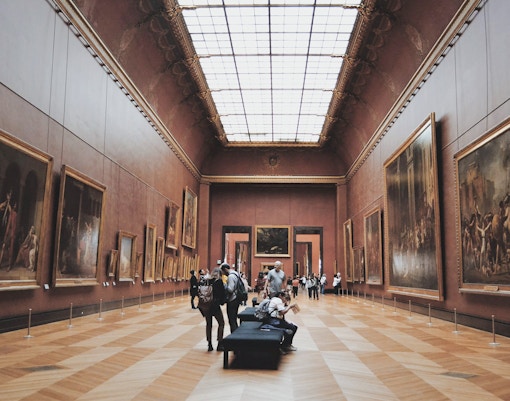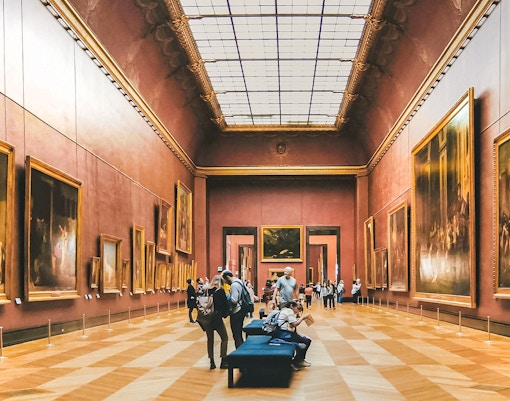- Louvre Museum
- Tuileries Gardens
- Eugène-Delacroix
- History
- Inside
- Collections
- Venus de Milo
- Mona Lisa
- Artworks
- Louvre at Night
- Louvre Pyramid
- Disneyland® Paris Tickets
- Eiffel Tower Tickets
- Paris Catacombs Tour & Tickets
- Versailles Tickets
- Notre-Dame Paris Tickets
- Orsay Museum Tickets
- Paris Pantheon Tickets
- Arc De Triomphe Tickets
- Opera Garnier Paris Tickets
- Centre Pompidou Tickets
- Big Bus Paris Hop-on Hop-off Tours
- Parc Astérix Paris Tickets
- Sainte Chapelle Tickets
- Les Invalides Tickets
- Eurail Passes
- Musee de l'Orangerie Tickets
Louvre Museum Paris | Discover the Most-Visited Museum In The World
The Louvre Museum (Musée du Louvre) in Paris is one of the world's largest and most renowned art museums. Located on the banks of the River Seine, it holds an unparalleled collection of art and historical artifacts, spanning over 9,000 years of hu...
Also Known As
Musée du Louvre
Founded On
1793
Founded By
King Philip II
Quick Information
ADDRESS
75001 Paris, France
RECOMMENDED DURATION
5 hours
Timings
Closed today
VISITORS PER YEAR
7500000
TICKETS
From € 24.90
NUMBER OF ENTRANCES
4
EXPECTED WAIT TIME - STANDARD
2+ hours (Peak), 1-2 hours (Off Peak)
EXPECTED WAIT TIME - SKIP THE LINE
30-60 mins (Peak), 0-30 mins (Off Peak)
UNESCO YEAR
1991
Did you know?
The Louvre’s story began over 800 years ago as a fortress defending Paris from Viking invasions. You can still see parts of the original medieval moat in the museum today.
During World War II, the Louvre’s deputy director, Jacques Jaujard, orchestrated a daring mission to hide over 4,000 priceless artworks in a château in Loire Valley to outwit the Nazis.
On 21 August 1911, Italian handyman Vincenzo Peruggia stole the masterpiece, Mona Lisa from the Louvre because he believed that she belonged in Italy. Her two-year disappearance made her a global sensation.
How To Buy Louvre Museum Tickets?
Plan Your Visit to Louvre Museum in Paris
Address: Rue de Rivoli, 75001 Paris, France
The Louvre museum is located inside the Louvre Palace, in the center of Paris, in the 1st district. It stands adjacent to the Tuileries Gardens.
Nearest Metro Station: Palais-Royal–Musée du Louvre

Monday to Sunday: 9 am to 6 pm
Friday: 9 am to 9:45 pm
Last Entry: 1 hour before closing
Closed On: Tuesdays, and on 1 January, 1 May, and 25 December. It remains open on all other public holidays unless they fall on a Tuesday.
Louvre Museum Collection
The massive collection of the world’s largest art gallery consists of over 35,000 artworks and it spans eight thematic departments. The vast collections include artworks and artifacts dating back centuries, representing almost 11,000 years of human history and culture. The museum’s permanent collection consists of great works of art by maestros like Leonardo Da Vinci, Delacroix, Rubens, and Vermeer, among others. It also houses Egyptian, Islamic, and Greco-Roman collections of art. The eight thematic departments of the Louvre are:

Paintings
The most popular section of Louvre Museum Paris, the painting department, exhibits more than 7,500 works of art. The department is further divided into schools of work based on regions such as French, Italian, German, Flemish, English, Dutch, and Scandinavian.
Know More
Egyptian Antiquities
The Egyptian collection of the Louvre is considered to be one of the most extensive in the world, housing over 50,000 pieces. It deep dives into the lives of the ancient Egyptians and includes artifacts from the Nile civilization (4,000 BC) to the 4th century AD.

Greek, Etruscan, and Roman Antiquities:
The Greek, Etruscan, and Roman antiquities department of the Louvre Museum focuses on Mediterranean history dating from the Neolithic era to the 6th century. One of the oldest departments of the Louvre, a large part of the collection was inducted by the French royalty in the 16th century.

Near Eastern Antiquities
This department is massive with 25 rooms dedicated to the exhibition of art and artifacts from early Near Eastern civilization. The department is divided into three geographic areas: the Levant, Mesopotamia (Iraq), and Persia (Iran).

Sculptures
The department for Sculpture at the Louvre Paris is rich with works created before 1850 that do not belong in the Etruscan, Greek, and Roman department. It holds the largest collection of French sculptures in the world. Some of the notable works are Satan by Jean-Jacques Feuchère and Diana the Huntress by Jean-Antoine Houdon, among others.

Islamic Arts
The department of Islamic Arts at the Louvre is the newest section in the museum. Founded in the year 2003, the collection features 3,000 works from the Arabian peninsula spanning the 7th to 19th centuries. Some important works showcased in this section are the Plate with Peacock, three pages of the Shahnameh, and the Barberini Vase.

Decorative Arts
The department of Decorative Arts at the Louvre consists of artifacts, tapestries, ceramics, stained glass, and more from the Middle Ages to the mid-19th century. Some highlights of the department include the coronation crown of Louis XIV, Giambologna's bronze Nessus and Deianira, and Napoleon III's apartments.

Prints & Drawings
This department houses the largest collection of drawings in the world with 1,40,000 pieces in the Louvre’s catalog. It is the least known part of the museum as most of the works cannot be displayed due to the fragility of the drawings. The collection is organized into three sections: the core Cabinet du Roi, royal copper printing plates, and the donations of Edmond de Rothschild.
Louvre Museum Highlights






Frequently Asked Questions About The Louvre Museum in Paris
The Louvre is an art museum and historic site in Paris. The museum, established in 1793, has an impressive collection of artwork and artifacts that trace 11,000 years of human civilization and culture.
Yes, you need tickets to enter the Louvre Museum in Paris. You can buy Louvre tickets online.
Yes, it is best to purchase your tickets in advance and online, to avoid waiting in long queues or not getting a spot on the day of your visit. You can purchase Louvre museum tickets here.
Yes, children under 18 years of age can visit the museum free of cost.
The Louvre is located at Rue de Rivoli, 75001 in Paris, France.
The Louvre is open Monday to Sunday from 9 am to 6 pm.
The best time to visit the Louvre is Friday evenings when the museum is open until 9.45 pm, and the crowd is comparatively less.
The Louvre is the world's largest and most-visited museum. It houses one of the most impressive art collections in history, with 480,000 works of art spanning centuries and regions.
The Louvre Museum opened to the public on 10 August 1793, making the museum 229 years old.
With galleries spreading over 15 acres, and an impressive collection of 480,000 works of art, the Louvre in Paris is the largest museum in the world.
The Louvre is extremely popular. An important landmark in Paris, the Louvre attracted approximately 9.6 million visitors in 2019, making it the most visited museum worldwide.
Inside the Louvre Museum you will find 35,000 works of art displayed across eight curatorial departments. You will find sculptures, decorative objects, paintings, drawings, and archaeological finds inside.
The Louvre collection includes over 480,000 artworks, of which 35,000 are on display.

